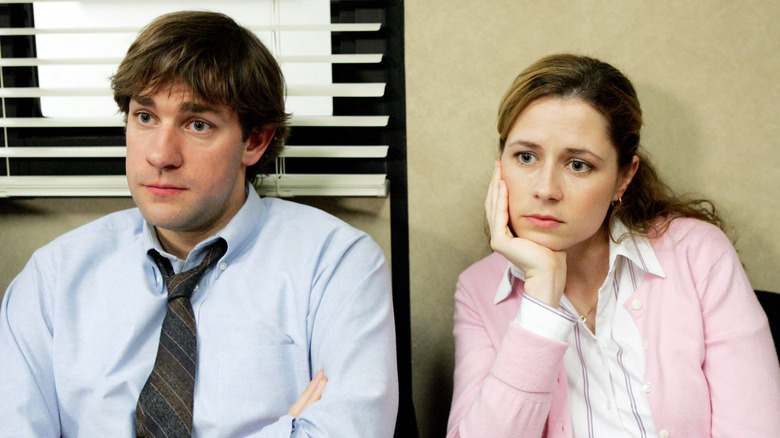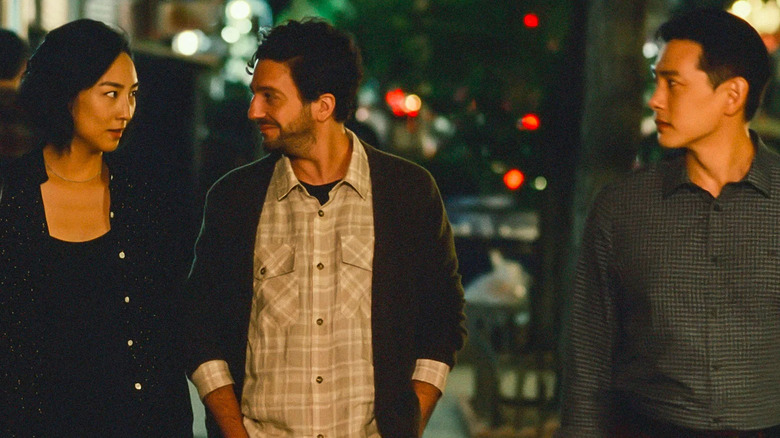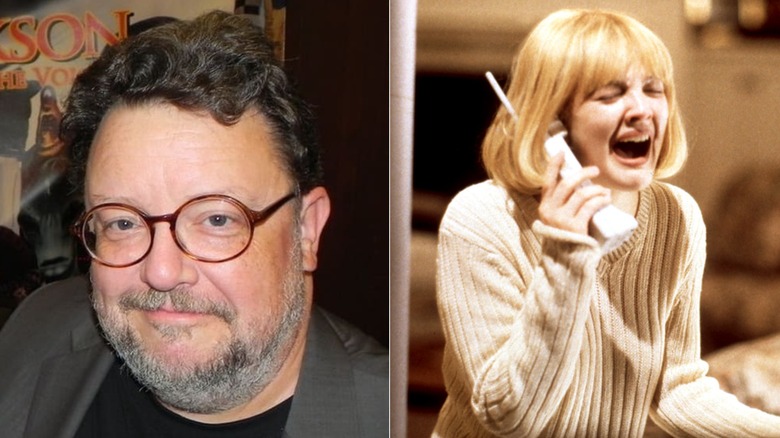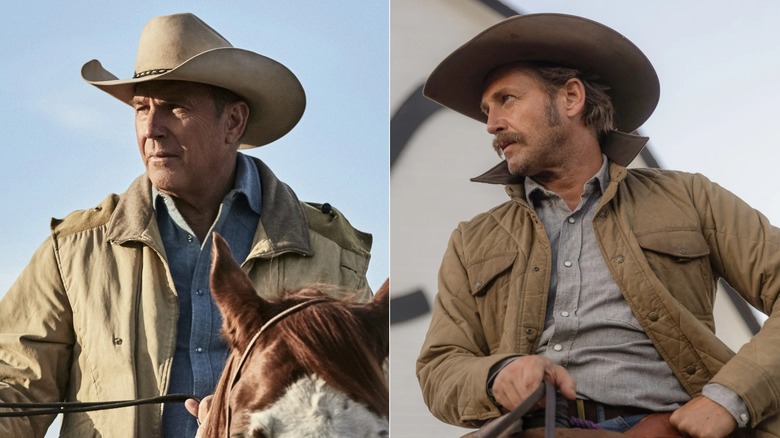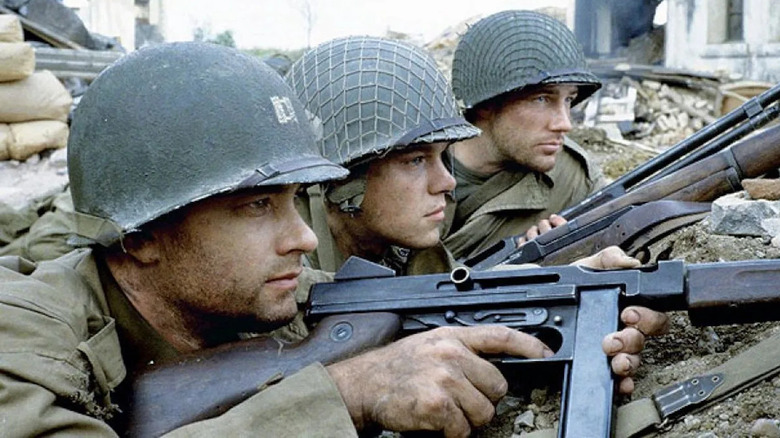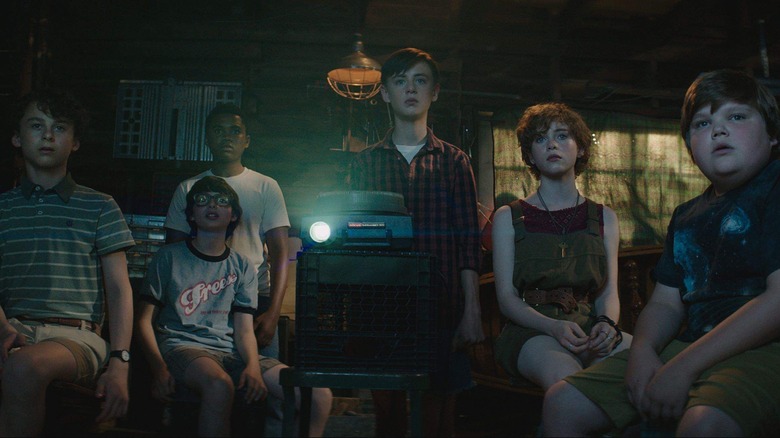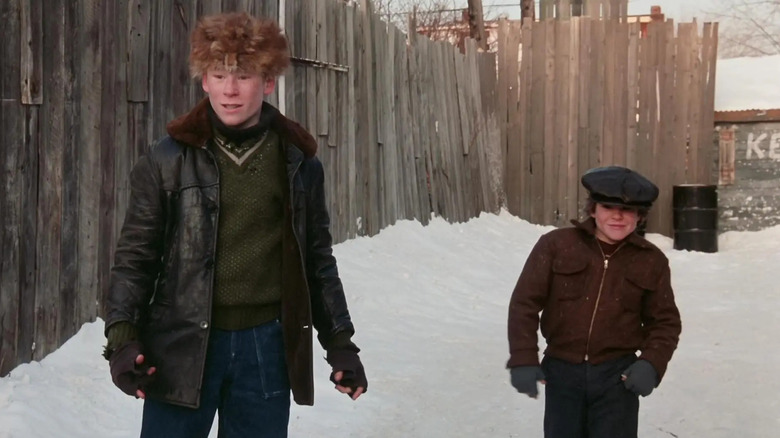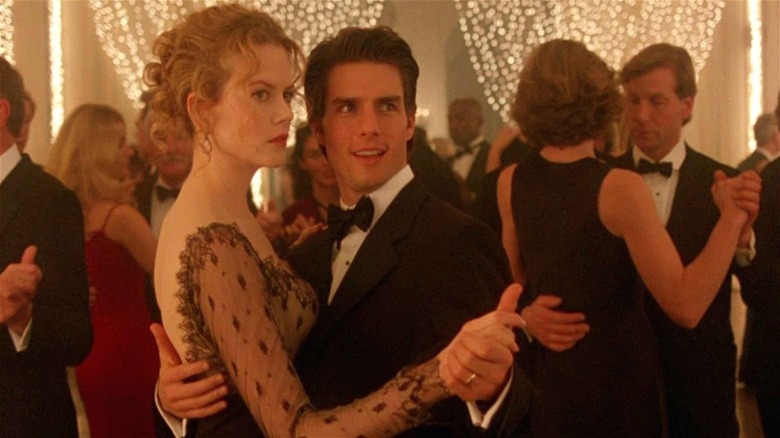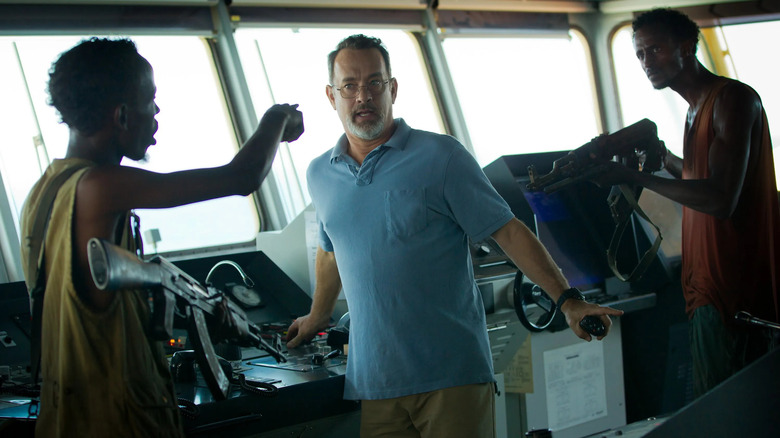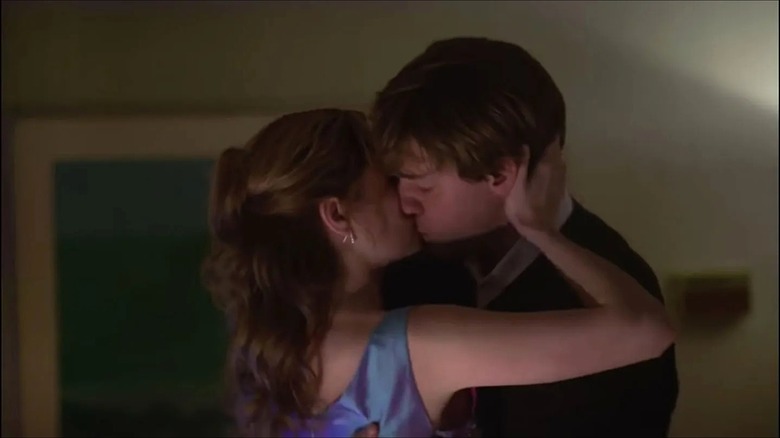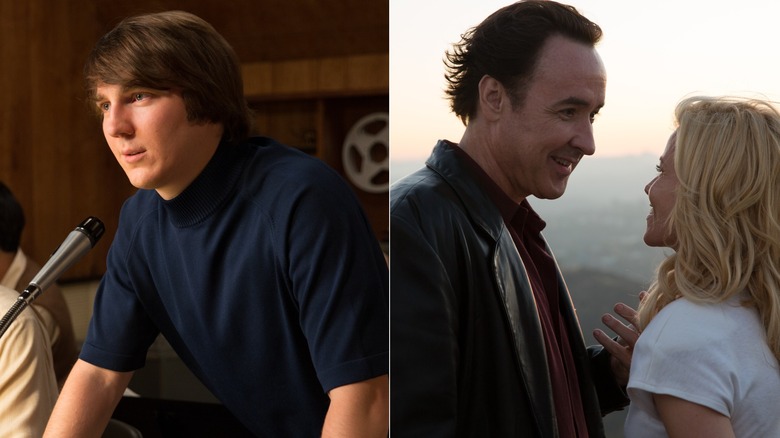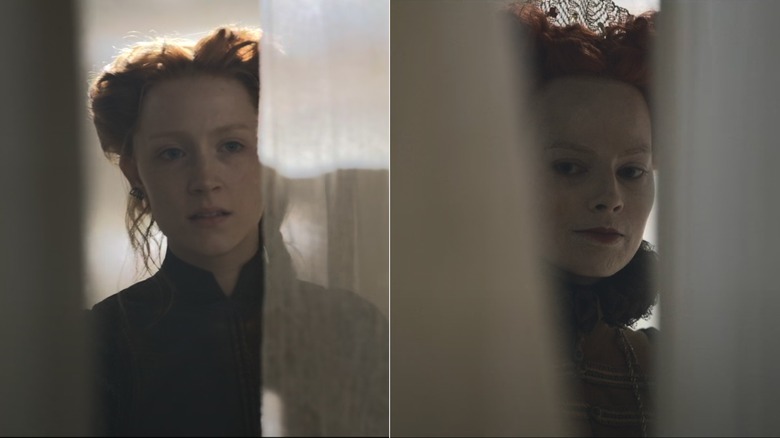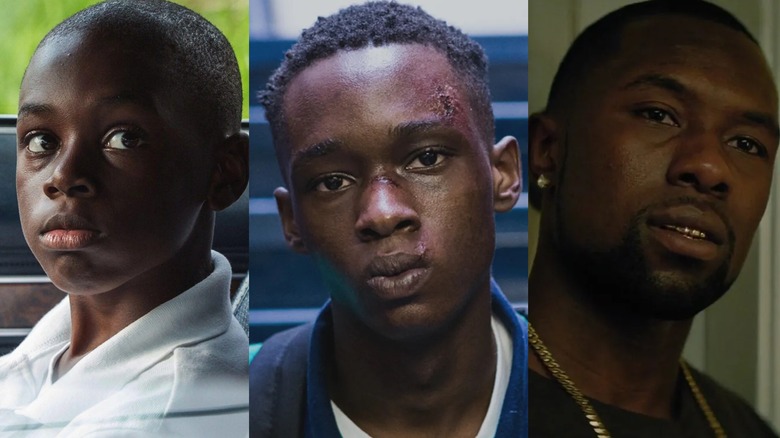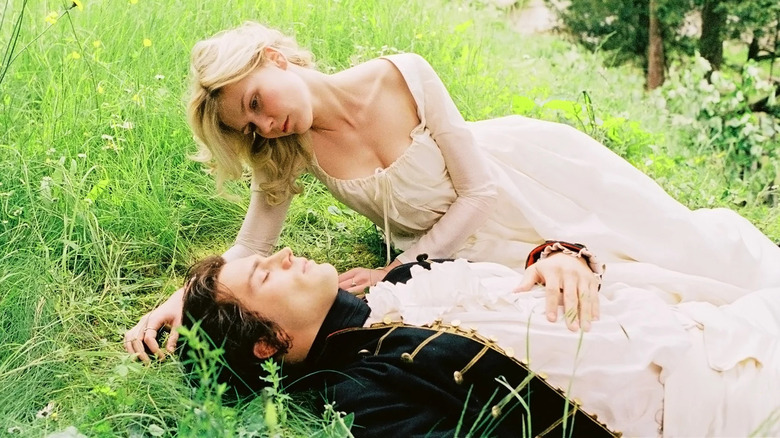13 Times Film Or TV Actors Were Deliberately Kept Apart During Production
The merits of Method acting have often been a matter of debate. But it's true that, in controlled doses, a commitment to the reality of a script can help a performance achieve that next level of authenticity. In other words, we're not suggesting that actors should send their costars dead rats as gifts, but one example that has proven to be effective is the separation of certain actors either on or off-set. Method actors sometimes do this on their own, but it actually occurs more often at the request of a show or movie's director.
Some productions keep actors apart because they are portraying different versions of the same character and the director wants to avoid overlap. Others do it because their characters simply don't meet and, to preserve secrecy, wouldn't want them to meet while production takes place. Still others do it to inspire tension and surprise when characters do meet. You might not even realize it, but some of your favorite movies may feature the moment two or more actors met each other for the very first time!
It's a powerful tool for a variety of genres: romance, thrillers, dramas, comedy, horror, and even the good old-fashioned biopic, all of which are represented in these 13 films and shows that kept actors apart.
Teo Yoo and John Magaro (Past Lives)
Hailed as one of the best films of 2023 so far, "Past Lives" is a film that, in many ways, is all about the forces that separate us. Celine Song's directorial debut follows Nora (Greta Lee) and Hae Sung (Teo Yoo), childhood sweethearts growing up in South Korea who reconnect later in life. After spending nearly a decade apart, Hae Sung arrives to visit Nora in New York City, only to reckon with her new life, specifically, her marriage to Arthur (John Magaro), an American man.
The film's lush romantic tension comes from how the three characters attempt to reconcile their differences, how they represent two very different outcomes in each other's collective fates. To maintain an initial sense of disconnect, Song told The Rolling Stone that she specifically kept Yoo and Magaro, who had never met previously, apart until the cameras started rolling. The scene in the film where they first meet is their actual first meeting, which makes the energy in that room all the more palpable. Song also had her male co-stars only hear about each other through Lee before filming, further reflecting the circumstances of the script.
In addition to Yoo and Magaro being separated, Lee and Yoo also kept their distance, though not to the same extent. The two began rehearsing on Zoom and later would rehearse together in person. However, Song was adamant that the two could not touch so their first hug in the movie would be the first time the actors touched in real life.
Roger Jackson and The Rest of The Cast (Scream) (1996)
Of the "Scream" franchise's many devious appeals, perhaps the most delicious is the mystery behind Ghostface. Thanks to the character's voice modulation, audiences are always kept in the dark as to who is messing with residents of Woodsboro, California. Thankfully, at least on the set of the first film, so were the actors. Sorta.
In a retrospective for The Hollywood Reporter, the cast and crew behind the first "Scream" film recalled Wes Craven's decision to have Roger Jackson, the iconic voice of Ghostface, on set but kept apart from the rest of the actors. Jackson's voice was "tapped into the phone," according to editor Patrick Lussier, but the actor himself was hidden in a separate room. However, on the first night of shooting, Jackson stood under a canopy outside the house, watching Drew Barrymore through the window as they filmed her iconic opening sequence. Actor Skeet Ulrich, who portrayed Billy Loomis, said that the cast knew someone was reading off-screen, but Craven's true intentions "never really crossed [their] minds" while filming.
Normally, when a scene partner is offscreen, an actor reacts to lines read by a script supervisor. If, as the saying goes, half of acting is reacting, it can be hard to recreate the same energy in a scene without your actual scene partner. By involving Jackson, Craven made sure the cast could act off of the "real" killer's voice while shooting phone call scenes while keeping an element of mystery intact. As observed by producer Marianne Maddalena, "Wes just got better performances out of them."
Josh Lucas and Kevin Costner (Yellowstone)
When actors are separated for a production, it's usually for the purpose of heightening the scene in which they meet. But, what if the characters never meet? Better yet, what if they're playing different versions of the same character? Assuming you aren't breaking the space-time continuum, this means that the actors would never meet during production, which happened on the set of Taylor Sheridan's Western drama series, "Yellowstone."
The show usually features veteran actor Kevin Costner as John Dutton, owner and operator of the Yellowstone Dutton Ranch. However, certain episodes feature flashbacks in which Josh Lucas portrays a younger Dutton. In an interview with Collider, Lucas revealed that Sheridan doesn't have Costner on set when Lucas shoots his scenes. "We're almost kept separate on purpose," he said, drawing similarities to Robert De Niro in "The Godfather Part II." Much like how De Niro did not want to merely imitate original actor Marlon Brando, Lucas stays away from Costner so he can put his own stamp on John Dutton.
In a later interview with Entertainment Tonight, Lucas said that he studied Costner's performance across every episode of "Yellowstone" in order to properly pay homage to his portrayal, but never shot with him. He also noted a similar case with Harrison Ford, who portrays great-great-uncle Jacob Dutton in the prequel series "1923." Ford did not speak to Costner about his performance "on purpose" so that he could "forge his own way."
Matt Damon and The Rest of The Cast (Saving Private Ryan)
If you've seen "Saving Private Ryan," this pick makes a lot of sense, though not in the way you might think. Steven Spielberg's devastating war epic does separate Matt Damon's James Francis Ryan from his fellow soldiers, but the separation began long before the cameras started rolling. In his episode of the hit YouTube interview series "Hot Ones," Damon confirmed a long-believed rumor that Spielberg did not allow him to attend the cast's pre-shoot "boot camp."
For six days, the cast of "Saving Private Ryan" endured an exhaustive training regimen in rainy weather conditions so that they could fully endure the physical and mental toll of serving as a soldier during World War II. They ran five-mile runs, executed attack simulations, learned how to hold and fire a weapon, and only slept three hours every night. By the time they were ready to shoot, they had been through the wringer.
Damon, however, had not. A self-described "young, diligent actor" at the time, Damon was a relative unknown eager to attend training and earn his stripes with the rest of the cast. Spielberg, however, did not allow him to attend. This was done to inspire a real, if not as aggressive, resentment for Damon within the cast, similar to the platoon's resentment for Ryan in the actual film. The choice paid off, as Damon jokingly described his co-stars as "totally resentful" of him by the time Spielberg rolled camera.
Bill Skarsgård and The Losers' Club (It Chapter One)
One of the many decisions director Andy Muschietti made in reimagining "It" and updating the source material was to turn a laughingstock of a character into one of modern horror's most terrifying antagonists. All of us were surprised by just how horrifying Bill Skarsgård was as Pennywise versus Tim Curry, so much so that Muschietti seized the opportunity to infuse that novelty into the final product.
In a Warner Bros. "It" featurette, the film's producers explain that Muschietti kept Skarsgård away from the film's ensemble of child actors for as long as possible following their first table read. According to one producer, Seth Grahame-Smith, this was done so that their reaction to the spine-chilling sewer clown was "authentic to how kids should be reacting." In an interview with news.com.au, Skarsgård said he felt "it was important the kids didn't see [him] in makeup until the first day of shooting" to keep his new look a mystery.
Needless to say, their methods worked. The first time the entire group saw the eponymous villain? While shooting the film's intense slide projector scene, during which Muschietti recalls that the kids "f**king freaked out" (via Daily Dead). When shooting his first individual scene with Pennywise, actor Jack Dylan Grazer told news.com.au that he was "genuinely scared," though Skarsgård would check in with him in between takes. "One minute he's asking if I'm OK ... and the next minute he's trying to choke me."
Zach Ward and Yano Anaya and The Rest of the Child Actors (A Christmas Story)
Of the many memorable performances in "A Christmas Story," Zack Ward provides a particular highlight as yellow-eyed bully Scut Farkus. The character is so beloved that he even ranks on several internets lists of the greatest Christmas villains ever, up there with The Grinch and Ebenezer Scrooge. Alongside Yano Anaya as toadie Grover Dill, the two cemented their sniveling grins into the hearts of holiday movie fans worldwide. But it took some distance between the other child actors to really pull it off.
In a 2022 interview with Insider, a grown-up Ward revealed that he and Anaya were separated from the other child actors to create "an innate nervousness" between what were neighborhood kids and their older-aged bullies. Director Bob Clark gave the two "different shooting schedules" and even advised their parents to have them hang out and become friends while specifically avoiding the other kids. Ward felt like the film succeeded in this regard, not only because he became best friends with Anaya, but because he could feel tension on set when shooting the bullying scenes.
That said, Clark insisted that Ward and Anaya's separation be done "without being rude to the other kids." In the end, the entire child ensemble got along, so much so that they all reprised their roles decades later in the film's streaming sequel, "A Christmas Story Christmas." The film portrays Scut Farkus as a police officer who, since being beaten up by Ralphie, has mended his ways.
Nicole Kidman and Tom Cruise (Eyes Wide Shut)
Method acting is already a dangerous game, but when you throw Stanley Kubrick into the mix, you start messing with fireworks. The director was very international when he cast Nicole Kidman and Tom Cruise in what would be his final project, "Eyes Wide Shut." He felt that the film, centered on a man paranoid over his wife's fantasized infidelity, would be all the more effective if it starred an actual, tabloid-hounded celebrity power couple. Kidman and Cruise wanted to work with a master of the craft, but neither of them could have predicted the extent Kubrick would go to lean into their insecurities.
In his work "Tom Cruise: An Unauthorized Biography," writer Andrew Morton explains that, during production, Kubrick directed Kidman and Cruise separately, not allowing them to share notes or discuss their individual shooting sessions. This came to a head when Kubrick and Kidman shot her character's nude scene, in which her character dreams about having an affair with a naval officer. It was a six-day shoot, with Cruise banned from attending. Kidman and her scene partner, model Gary Goba, performed more than 50 sexual positions as well as simulated oral sex, most of which was never going to make it into the final cut. Cruise didn't learn about these scenes until after he saw the finished film. Though neither Kidman nor Cruise has said the production put a strain on their marriage, many speculate that it played a role in their eventual divorce two years later.
Tom Hanks and the Somali Pirates (Captain Phillips)
The world met the extraordinarily talented Somalia actor Barkhad Abdi in Paul Greengrass' nautical thriller "Captain Phillips." So too did Tom Hanks, but only when the cameras started rolling. Hanks encountered Adbi and his character's crew for the first time during the sequence in which the Somali pirates approach the Maersk Alabama and bust onto the bridge.
Speaking to NPR about the choice to separate the actors, Greengrass said that he wanted the young pirates, all of whom had never acted professionally before, to "terrorize and threaten and be believable." In a separate interview with The Hollywood Reporter, Abdi reminisced about Greengrass informing him of the plan. Abdi, a fan of Hanks' work –- especially "Forrest Gump" –- felt a bit deflated, but knew the scene would play more authentically if they shot it that way.
In both interviews, Hanks recalled the experience of shooting their meeting as intimidating but exciting. The foursome's sudden high energy caused the hairs on the back of his neck to stand up, and he described them as "scary in the ... best possible way." The confrontation became so chaotic that the "rules" of the scene, as Hanks worded it, quickly got thrown out. Abdi even went off-script and came up with what remains the film's most famous line: "I am the captain now." However, after the tension died down, Hanks and the Somali ensemble became friendly in-between takes. I hope they got to talk about Forrest.
John Krasinski and Jenna Fischer (The Office)
Many of these examples involve actors being kept apart for an extensive amount of time, usually weeks or even months. However, quality results can also be achieved with just a dose of separation. That's what happened when the cast and crew of "The Office" shot the Season 2 finale, "Casino Night." Many fans consider the episode to be one of the show's finest, in part thanks to its climactic first kiss between Jim (John Krasinski) and Pam (Jenna Fischer).
On Fischer's "Office" rewatch podcast, "Office Ladies," John Krasinski appeared as a special guest to discuss the episode's big smooch. Fischer remembered that, after blocking the scene, she was told by showrunner Greg Daniels and director Ken Kwapis to "go back to [her] trailer and not leave until [she was] called ... don't speak to John and just be alone." Fischer also never rehearsed the scene with Krasinski. According to co-host Angela Kinsey, who portrayed Angela on the show, the creative team wanted Krasinski's first time seeing Fischer in the context of the scene to be "on 'Action.'"
In a later episode of the podcast, Kwapis made his own guest appearance to elaborate on the decision to separate the two. The director described the kiss as a moment that "upends everything" in their relationship, so he sought to knock them "off balance." That, in combination with moody set lighting, made it "a whole new experience" for Fischer, but one that provoked the desired effect.
Paul Dano and John Cusack (Love & Mercy)
Consider this another example of an older and younger actor being kept apart so they could each play the same person, just differently. "Love & Mercy" tells the story of legendary Beach Boys frontman Brian Wilson and his struggles with mental illness, alternating between the '60s and '80s. Paul Dano and John Cusack portray younger and older versions of Wilson, respectively, but the two never discussed their portrayals and were encouraged to remain apart while playing the characters.
In an interview with AwardsDaily, Dano said that he didn't meet Cusack until his last day of shooting, which was also Cusack's first. He compared the experience to "two separate films being made" and believed there was "a lot of strength in [the] juxtaposition" of his and Cusack's embodiments of Wilson during two very different eras in his career. Instead, Dano dove into the pop virtuoso's music, believing he could learn the most about Wilson there.
Speaking to Film Journal International, director Bill Pohlad corroborated that the actors were kept apart "on purpose." He explained that he wanted both actors to "find their own Brian Wilson" as opposed to simply attempting imitation, though he did encourage Cusack to work directly with Wilson, which he did. Pohlad was not interested in making a stereotypical biopic but rather a spiritual portrait of Wilson not beholden to exact accuracy. Eventually, everyone met; Dano and Wilson would even go on to perform together at the film's DVD launch party in Los Angeles in 2015.
Saoirse Ronan and Margot Robbie (Mary Queen of Scots)
Those wishing for a Ronan/Robbie two-hander were left wanting more after watching "Mary Queen of Scots," a dual biopic featuring the popular actresses as the eponymous Queen of Scotland and Queen Elizabeth I, respectively. The two share one scene toward the film's end, a meeting that, according to history, never happened. Still, it delivers an emotionally charged standoff, one made all the more intense knowing it was the first time the actresses had seen each other in weeks.
Ronan and Robbie were adamant that they did not want to see each other in character while shooting, describing it to Deadline as a "fun experiment" to make their culminating meeting feel more authentic. Robbie shot all of her scenes as Queen Elizabeth I before her encounter with Mary, which represented Ronan's first day on set. Their separation wound up greatly reflecting the characters' relationship in the film; Robbie felt "a pang of envy" for Ronan's lighter experiences on set, while Ronan herself found it "exhilarating" to imagine the world outside of her scenes. Most importantly, their longing to connect in real life colored the characters' longing to meet.
After three weeks of separation, the actresses found themselves incredibly emotional on set. Speaking to The New York Times, Robbie said that she "fell apart completely," describing it as "one of the most extraordinary acting moments [of her] life." And, in an interview with Entertainment Weekly, Ronan stated that the two were "blubbering like idiots" as they held each other when finally reunited.
Alex R. Hibbert, Ashton Sanders, and Trevante Rhoades (Moonlight)
If you think two people playing the same person makes for an interesting character portrait, imagine three. This was the conceit of Tarell Alvin McCraney's play "In Moonlight, Black Boys Look Blue," which served as the inspiration for Barry Jenkins' extraordinary sophomore feature, "Moonlight." The story follows a black man during three different periods in his life, periods so distinct from one another that he goes by three separate names.
Naturally, a different actor portrays each version of the character, but Jenkins was so sensitive to them mimicking each other that he "forbid them" from meeting, as described in an interview with Dazed. Because the world shapes the character to become three different versions of himself, Jenkins wanted three separate performances that still captured the same boyish essence. He cast the film's three stars (Alex R. Hibbert, Ashton Sanders, and Trevante Rhodes) based on "the same kind of vibe and spirituality," though he also told The Christian Science Monitor that he felt the actors had "a connection through their eyes."
Though Sanders and Rhodes briefly met while shooting, none of them engaged in extended conversations with each other, despite all of them being anxious to meet. It wasn't until the film's premiere screening at the Toronto International Film Festival that the three were properly introduced, after which they all bonded over sharing the same character in one of the year's most beloved films. In an interview with W Magazine, Sanders said that the three felt "immediately like [they] were a family."
Jamie Dornan and Kirsten Dunst (Marie Antoinette)
In Sofia Coppola's brazenly modern period drama "Marie Antoinette," the titular character, portrayed by Kirsten Dunst, first meets Count Axel von Fersen, portrayed by Jamie Dornan, at a masquerade ball. The Count approaches her and asks a simple question: "Do I know you?" Antoinette responds, "No, I don't think so." This is true within the film but also was the case for Dunst and Dornan themselves, who met for the very first time shooting this very interaction. Talk about flirting.
Though specific details remain scant, Dornan confirmed in Vogue's retrospective "oral history" of "Marie Antoinette" that Coppola "cleverly arranged it" so that the two didn't meet until they "rolled the cameras." Dornan deemed it "an incredible way to get thrown into the character," especially as a young Irish actor working his very first gig. Dornan signed on with his agent just six days before flying out to Paris to audition for Coppola, after which the young director gave him the part.
Historians routinely debate whether or not Antoinette and Fersen's close friendship ever crossed the line, whereas Coppola went all in on a steamy love affair between the two nobles. Whilst reminiscing during their episode of Variety's "Actors on Actors" interview series, Dunst and Dornan recalled meeting for the first time on set and how that contributed to the "awkward"-ness of having to be physically intimate in almost every scene together. Dunst said she felt like she had to be the "chill" one between the two of them, even though she felt "very nervous" and "overwhelmed" by the sexual nature of the scenes.
